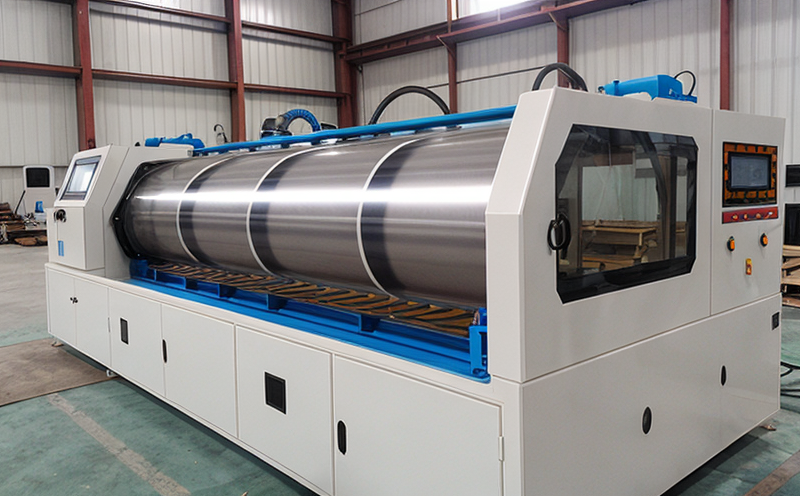ISO 2286-3 Rubber or plastics coated fabrics Determination of tensile strength and elongation
The ISO 2286 series provides a standardized method for determining the mechanical properties of rubber or plastics coated fabrics. Specifically, ISO 2286-3 focuses on the determination of tensile strength and elongation in these materials.
This test is crucial in ensuring that textile products meet regulatory standards and customer expectations. It helps manufacturers confirm the durability and integrity of their coated fabrics under various conditions. The tensile strength measurement indicates how much force a sample can withstand before it breaks, while elongation measures the percentage increase in length experienced by the fabric during the testing process.
The procedure involves mounting a specimen on a tensile tester equipped with specific grips to ensure accurate measurement of stress and strain. The specimen is subjected to gradually increasing loads until failure occurs. Detailed records are kept throughout the process, including the maximum load applied before breakage and the stretch percentage at that point.
Understanding these properties is essential for industries such as automotive, footwear, and outdoor gear manufacturing. For instance, in automotive upholstery, knowing the tensile strength of rubber-coated fabrics ensures that seat covers can withstand the rigors of everyday use without tearing or deforming. Similarly, in athletic shoes, understanding both tensile strength and elongation helps ensure comfort and longevity.
The test is also vital for compliance with international standards like ISO 2286-3 itself, as well as other relevant specifications such as ASTM D1412. Compliance with these standards can enhance brand reputation by demonstrating adherence to high-quality benchmarks.
In summary, the determination of tensile strength and elongation in rubber or plastics coated fabrics is a critical step in quality assurance processes within various sectors. By employing this standard procedure, manufacturers ensure that their products are reliable, safe, and meet consumer demands.
Scope and Methodology
The scope of ISO 2286-3 encompasses the mechanical properties testing of rubber or plastics coated fabrics. This includes the determination of tensile strength and elongation, which are key indicators of a fabric's durability and flexibility.
| Parameter | Description |
|---|---|
| Tensile Strength | The maximum stress that a material can withstand before breaking. It is measured in MPa or psi. |
| Elongation | The percentage increase in length of the specimen after it has been subjected to a specified load until failure. |
The methodology involves mounting the fabric sample onto a tensile testing machine, which applies a controlled force. The machine records the stress and strain values as the specimen stretches and eventually breaks. This data is then analyzed according to ISO 2286-3 guidelines to determine the tensile strength and elongation.
The test setup typically includes specific grips designed for coated fabrics to prevent slippage or damage during testing. The process also involves calibration of the testing machine to ensure accurate measurements. Samples are prepared by cutting them into standard lengths, ensuring that they represent typical usage conditions in real-world applications.
Once tested, results must be reported according to ISO 2286-3 specifications. This includes documenting the specimen dimensions, applied force, and any other relevant factors affecting test outcomes. These detailed records help ensure consistency across different batches or suppliers of coated fabrics.
Why Choose This Test
Selecting ISO 2286-3 for determining tensile strength and elongation in rubber or plastics coated fabrics offers several advantages. Firstly, it ensures compliance with international standards, enhancing product reliability and safety. Secondly, this test provides precise measurements of critical mechanical properties, which are crucial for quality assurance processes.
For manufacturers operating globally, adherence to ISO 2286-3 can significantly improve brand reputation by demonstrating commitment to high-quality benchmarks. Additionally, the detailed nature of these tests allows for more accurate predictions about how fabrics will perform under various conditions, leading to better product design and development.
The test results also play a vital role in ensuring consistency across different production batches or suppliers. By using standardized procedures like those outlined in ISO 2286-3, manufacturers can maintain consistent quality levels, which is essential for maintaining customer satisfaction and trust.
Furthermore, the data collected from these tests can be used to identify areas where improvements could be made. For example, if a particular batch of coated fabric consistently fails to meet expected tensile strength or elongation values, further investigation may reveal issues with raw materials, manufacturing processes, or quality control measures.
In conclusion, choosing ISO 2286-3 for determining tensile strength and elongation in rubber or plastics coated fabrics provides numerous benefits. It ensures compliance with international standards, improves product reliability, supports accurate predictions about fabric performance, maintains consistent quality levels, and aids in identifying areas for improvement.
Use Cases and Application Examples
- Automotive upholstery: Ensuring seat covers can withstand the rigors of everyday use without tearing or deforming.
- Athletic shoes: Ensuring comfort and longevity by understanding both tensile strength and elongation.
- Outdoor gear manufacturing: Guaranteeing that fabrics used in tents, backpacks, and other outdoor equipment are durable and flexible.
| Industry | Application | Expected Outcome |
|---|---|---|
| Aerospace | Testing materials for aircraft interiors to ensure they can withstand harsh environments. | Identifying suitable fabrics that meet strict durability requirements. |
| Military | Evaluating textiles used in military uniforms and equipment to guarantee safety under extreme conditions. | Determining the best materials based on their tensile strength and elongation capabilities. |
| Construction | Assessing durability of roofing membranes and wall coverings to ensure they last under varying weather conditions. | Selecting appropriate coatings that enhance fabric performance in harsh environments. |
In each case, the test results help manufacturers make informed decisions about material selection and process optimization. This ensures that products meet not only regulatory requirements but also exceed customer expectations regarding quality and reliability.





